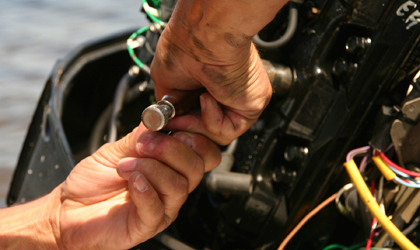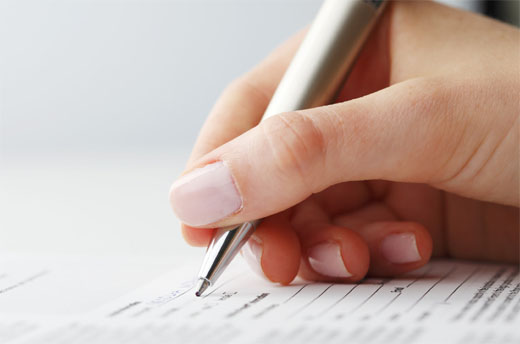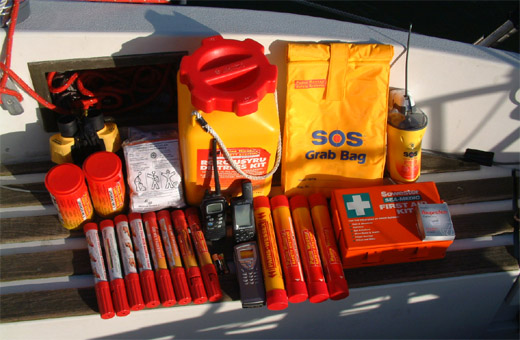|
Whether you keep boat at a marina or on a private pier, there are lots of advantages to keeping it on a lift. You don’t have to paint the boat’s bottom, you’ll never worry about a line coming loose and the boat banging into the pier, and your boat most certainly won’t sink in the slip. Check out this quick video to see a lift in action, learn a few important tips for lift-keeping a boat, and discover a couple of down-sides, too.
Just how big an issue is that expense? This depends to some degree on just how large your boat is. A small skiff, like the 16 Carolina Skiff center console you see in the video, weighs a little over 1,000 pounds with the motor and a load of fuel. Other than PWC lifts, most boat lifts start in the 2,500 to 3,000 pound capacity range—and you do need to plan for additional lift capacity beyond the boat’s weight, to account for people stepping on the boat, gear, and other things that may increase the load. A 3,000 pound lift will cost between $4,000 and $5,000, plus installation. Jumping to double the capacity only increases the lift’s cost by a few hundred dollars and boosting it from there to 8,000 or 10,000 pounds only increases cost by 10 to 20 percent. So most people opt for a lift with substantially more capacity than they need at the moment, to account for future upgrades.
What if you want to consider one of those faster hydraulic lifts? These models usually range from between $6,000 (for a 4,000 pound lift) and $20,000 (for a 15,000 pound model). You can learn a lot more about this option by reading The Best Boat Lift: Shore Station vs. HydroHoist vs. Sunstream.
The other down-side we mentioned is hurricanes. Boats on lifts are actually subject to just as much damage as those in slips, because scuppers can get clogged with flying debris (and then the boat fills with water), rising water levels can swamp the boat if it’s tied down or float it free if it’s unsecured, and the elevation subjects them to wind damage. Plus, many people get lulled into a false sense of security when their boat’s on a lift, and fail to properly prepare it for the storm. Just like boats kept in the water, the best move is usually to pull the boat before the storm hits and store it on dry land.
If you feel a lift is right for you, whichever type you opt for remember those tips we covered in the video:
About Navnit Marine Private Limited :
Navnit Marine provides Luxury Motor Boat Servicing in Mumbai India at its Marina at Uran. You can avail yacht management services from us.We offer owners a management support service capable of handling the full spectrum of yacht operations. Our dedicated team has the vast knowledge and experience to deliver solutions. We provide owners with reduced costs and downtime with effective management and budget controls. Ultimately, giving owners greater safety, enjoyment and peace of mind.
To Know More About Motor Boat Servicing in Mumbai India , Contact Navnit Marine at 022 6677 6659 or Mail us at info@navnitmarine.comWe have various Yachts and Boats Like Princess Yachts, Bayliner Boats, Meridian Yachts and Many More.
Source - boats.com
| |
Tuesday 30 August 2016
Boating Tips: Is A Boat Lift Right For You?
Tuesday 23 August 2016
Choosing The Right Fuel And Oil For Your Marine Engine
Your boat’s engine powers your on-water adventures, so keeping it well-maintained is critical for making the most of your time on the water. Using the right type of oil and fuel is critical for both performance and lifespan.
There are two main categories of marine outboard engines: two-stroke and four-stroke. Most new engines shipped today are four-stroke, however, there are still a large number of two-stroke engines on the water.
The lubrication requirements of two-stroke and four-stroke engines are very different because of the way each system works. In two-stroke engines, the oil is mixed with the fuel and lubricates the engine as it passes through. It burns along with the fuel and exits via the exhaust system. Four-stroke engines are lubricated by oil that repeatedly is pumped from and returned to a sump, just as in a car or truck
Newer boat engines are also engineered to be consumer and environmentally friendly —with reduced emissions and extended lifespans. However, these advanced technologies place severe demand on engine lubricants and make it critical to choose the correct lubricant for your engine.
Use the right lubricant — Marine and auto oil are not interchangeable.
Although oil in a four-stroke marine engine performs the same function as it does in an automobile engine, passenger car motor oil should not be used in marine engines. The two primary reasons for this: water and wear.
Consider that corrosion caused by water is a primary concern for marine engines. Oils made for cars are not designed to provide the high level of corrosion protection marine engines require.
Car oils also fall short in the protection department. Because four-stroke outboard engines run faster than car engines, spend long periods running at extremes of speed and can spend long periods out of use, they have very specific requirements for anti-wear protection that car oils do not provide.
The best way to protect your engine is to use the outboard engine oil recommended by the engine manufacturer or to look for the National Marine Manufacturers Association (NMMA) logo on the oil. NMMA tests and certifies oils to ensure they meet marine engine needs.
Use the following list to determine the correct oil for your boat’s engine:
- TC-W3 oils are certified for two-stroke engines
- FC-W products are certified for four-stroke marine engines
- FC-W Catalyst Compatible covers oils intended for use in 4-stroke engines that have an exhaust after-treatment catalyst
Use the right fuel—Understand the Ethanol Issue
Using the right fuel is also critical to the performance and life span of your outboard engine. In the United States the introduction of ethanol into the fuel supply to meet the mandates of the Renewable Fuel Standard has had unintended consequences for boaters.
Currently, the Environmental Protection Agency (EPA) is pushing to change the automotive/light duty truck fuel standard from the current 10 percent ethanol (E10) used in many gasoline blends to 15 percent ethanol (E15). Consequently E-15 is expected to become the predominant fuel in the U.S. marketplace in the next 10 to 15 years.
This presents a problem for boaters because tests conducted by marine engine manufacturers under the direction of the Department of Energy’s National Renewable Energy Laboratory concluded that E15 fuels not only damage marine engines, but also caused them to exceed EPA emission standards.
Fortunately, any retailer that chooses to sell E15 fuel must post warning labels at the fuel pump. The key for boaters is to pay attention to the labels and not use E15 to fill up at the pump. Marinas, of course carry gasoline without ethanol, and are probably the safest place to fill up if you do not want to worry about the gas you are using in your boat.
About Navnit Marine Private Limited :
Navnit Marine provides Luxury Motor Yacht Servicing in Mumbai India at its Marina at Uran. You can avail yacht management services from us.We offer owners a management support service capable of handling the full spectrum of yacht operations. Our dedicated team has the vast knowledge and experience to deliver solutions. We provide owners with reduced costs and downtime with effective management and budget controls. Ultimately, giving owners greater safety, enjoyment and peace of mind.
To Know More About Motor yacht Servicing In India, Contact Navnit Marine at022 6677 6659 or Mail us at info@navnitmarine.com
We have various Yachts and Boats Like Princess Yachts, Bayliner Boats, Meridian Yachts and Many More.
Source - discoverboating.com
Tuesday 16 August 2016
Anchoring Tips: A Scrape In The Dark
It is a horrible feeling to wake up at 3:00 am after spending the day on the water and finding a perfect anchoring spot, only to realize that the winds have picked up just a little bit and dragged your boat against another nearby boat, or worse, into the middle of a shipping lane, or onto rocks. Described here are some of the common causes of this problem, and some descriptions of how to avoid them. Equally annoying and embarrassing is anchoring your boat while going to supper or acquiring supplies and finding the boat gone when you return. Your immediate thought is that it has been stolen and so you call the police. If you are lucky, the boat is found an hour or two later drifting, the anchor still attached, but pulled up from it's original location.
Wind Dragged Boat or a Wind Direction Change
This can occur even if you have the right anchor type and size. All it takes is for the anchor to be set not quite perfectly or for the bottom to be poor. Then, a bit of wind will start dragging the anchor. Or, the wind will change direction, causing the anchor to become dislodged. You need to use two anchors set in a V shape at the front of the boat. Then, even if one drags, the other is still tight. If you expect a really bad storm, use three anchors set like a V with an extra line straight out front.
Tight Anchorage
There are degrees of tightness in anchoring. If you have room for the boat to swing around without hitting anything, then you can just use a two anchor V, where the angle between the two anchors is fairly large (between 140 and 180 degrees, closer to 180 for less movement, but requiring larger anchors). This keeps the bow in one place, but allows the stern to swing around, keeping the wind head on (this is usually more comfortable for sleeping.) However, if there isn't room to turn the boat around, either due to other boats, the shore or underwater objects, then you need to set a V anchor set at the front, and an additional anchor at the back. This keeps the boat stationary, but tends to be less comfortable. An alternative, if the wind is coming from the stern, is to put the V anchors at the stern and a single anchor at the front. Sometimes you can use trees on land as one of the anchors.
Tide Lifted Anchor
Fresh-water boaters can be surprised by tides. If you set an anchor at low tide, giving it a reasonable amount of rode, even setting a second anchor, you can still be surprised to find yourself adrift. What happens is that the boat comes up on the tide (which can be as much as 14' or 4.5 m, but more typically around 3 ft or 1 m). This adds six times that length to the amount of rode you need, so 18 ft or 6 m more rode. It doesn't actually lift the anchor, just lets the angle decrease enough that the anchor doesn't hold. The trick to setting an anchor in tidal waters is to know how much extra rode high tide is going to need, or just add an extra 20-30 ft.
Another thing you should think about when anchoring at HIGH tide, is whether you will have enough depth at low tide. You don't (generally) want to ground yourself due to anchoring in too shallow water.
Improper Anchor Type or Size
When you purchase an anchor, make sure you get the right type for the bottom conditions where you go boating. Most boating stores can help you decide on the type of anchor, but don't be cheap, buy at least 1 good, heavy anchor for each type of bottom you expect to have to anchor on.
To Know More About Boats and Yachts Dealer in India, Contact Navnit Marine at022 6677 6659 or Mail us at info@navnitmarine.com
We have various Yachts and Boats Like Princess Yachts, Bayliner Boats, Meridian Yachts and Many More.
Wednesday 10 August 2016
Why Make A Float Plan?
Why should you take the time to prepare a float plan? The answer is simple... there are just too many facts that need to be accurately remembered and ultimately conveyed in an emergency situation. Without a float plan you are counting on someone else, a friend, neighbor, or family member to remember detailed information that rescue personnel need in order to find you. Information that can make a difference in the outcome.
Why make a float plan?
In an emergency situation there is a lot of crucial information that needs to be communicated with the emergency services. It can be hard to remember everything, and without a float plan you are counting on someone else to remember all of the detailed information that rescue personnel need in order to find you. Getting accurate information quickly to the emergency services will make a difference in the outcome.
Who should use a float plan?
Whether you are a kayaker going out for an afternoon, or the captain of a 80m super yacht, you should complete a float plan and file it. Some of the types of water users that may use float plans are:
- Kayakers
- Sport fisherman
- Hunters
- Jet Skiers
- Water skiers
- Family day cruisers
- Private charter boat services
- Canoeists
- Rowers
- Rafters
- Sail boaters
- Power boaters
Typically, the Skipper of the vessel is the individual who prepares the Float Plan. However, any member of the crew can be assigned the preparation and filing duty.
To Know More About Boats and Yachts Dealer in India, Contact Navnit Marine at022 6677 6659 or Mail us at info@navnitmarine.com
We have various Yachts and Boats Like Princess Yachts, Bayliner Boats, Meridian Yachts and Many More.
Source - grenadabluewatersailing.com
Friday 5 August 2016
What To Put In A Grab Bag?
A grab bag is a vital piece of safety equipment
should be there in your boat that must be prepared and ready to go in
case of an emergency such as a serious fire, sinking vessel, or medical
evacuation.
The contents
may differ slightly depending on whether you are coastal sailing,
heading offshore on a transatlantic crossing, or have a budget to
consider.
It is important to put careful consideration into
choosing the right emergency equipment for your sailing vessel and
planned passage. When it comes to the crunch you don’t want your grab
bag to be ill-equipped.
A grab bag is a vital piece of safety equipment.
Life Raft Basic Survival Kit
Many life rafts come with a basic sea survival kit included. The contents can vary, so it is a good idea to check what is included with your life raft onboard. You can adapt the grab bag to suit your vessel requirements.
Some Life Raft
comes equipped with: a rescue quoit with 30m of line, pair of oars,
sponges, bailer, waterproof torch & batteries, life saving signal
card, red hand flares, floating knife, sea anchor, set of repair clamps
and a hand pump.
Some Liferaft Equipment Pack includes: a
rescue quoit & 30m line, paddles, bailer, sponges, pump, repair kit,
sea anchor & line, whistle, waterproof torch, signalling mirror,
survival instructions & liferaft manual, solas card of distress
signals, floating liferaft safety knife, sea sickness tablets, solas red
hand flares, solas red parachute rockets, solas external lighting
system, rainwater catching system on canopy and an insulated thermal
floor.
Types of Grab Bag
A grab bag needs to be completely waterproof with the ability to float. A roll-top dry bag is adequate, or a rigid flare canister. It is a good idea to have a line attached to the grab bag so it can be tethered if necessary. There are a range of grab bags available to buy, or if you purchase a ready-made pack then it may include the grab bag too.
Abandoning Ship – Where to Place Your Grab Bag
The grab bag needs to be stored in an easy-to-reach position in case of emergency. All crew members should be briefed on its location and contents. It should be the first item picked up in an abandon ship/evacuation procedure. Any non-essential equipment can be gathered (if there is enough time) before boarding the life raft.
Essential Grab Bag Items
- Passport, cash/credit cards and ship’s log/papers
- Handheld VHF
- Drinking water
- Flares
- First Aid Kit/Medication
- Food
- Navigation tools
- Knife
- Foil blankets
- Torch & batteries
- Bailer/hand pump
- Oars
- Signalling mirror & whistle
- Sea anchor.
Additional Grab Bag Items
- EPIRB/PLB
- Laser flares
- Satellite phone
- Watermaker
- SART
- Fishing kit/spear gun
- Life raft repair kit
- Spare glasses
- Pack of cards
- Sunscreen
- Spare 30m line.
You should access and update your
grab bag regularly to ensure nothing is out-of-date and that items
such as batteries and electronics are in good working order.
To Know More About Boats and Yachts Dealer in India, Contact Navnit Marine at 022 6677 6659 or Mail us at info@navnitmarine.com
We have various Yachts and Boats Like Princess Yachts, Bayliner Boats, Meridian Yachts and Many More.
Subscribe to:
Posts (Atom)




